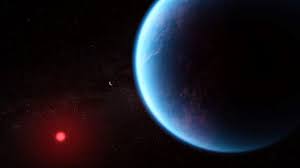
In a groundbreaking discovery, NASA astronomers using the Hubble Space Telescope have identified the smallest exoplanet where water vapor has been detected in the atmosphere. The planet, named GJ 9827d, is approximately twice the diameter of Earth, offering insights into the potential existence of planets with water-rich atmospheres beyond our solar system.
Discovered by NASA’s Kepler Space Telescope in 2017, GJ 9827d orbits a red dwarf star every 6.2 days and boasts a scorching temperature of 800 degrees Fahrenheit—comparable to Venus. Situated 97 light years away in the constellation Pisces, this newfound exoplanet has now become a focal point for scientific exploration.
“This would be the first time that we can directly show through atmospheric detection that these planets with water-rich atmospheres can actually exist around other stars,” stated Bjorn Benneke, a member of the team from the Trottier Institute for Research on Exoplanets at the University of Montreal.
The researchers are confronted with intriguing possibilities regarding GJ 9827d. It could either retain a hydrogen-rich envelope with water, resembling a mini-Neptune, or represent a warmer version of Jupiter’s moon Europa, potentially composed of half water and half rock.
Observations by the Hubble program, spanning 11 transits over three years, played a pivotal role in this discovery. During transits, starlight passing through the planet’s atmosphere revealed the spectral fingerprint of water molecules, enabling astronomers to directly detect the presence of water vapor.
Thomas Greene, an astrophysicist at NASA’s Ames Research Center, emphasized the significance of observing water, stating, “Observing water is a gateway to finding other things.” NASA’s focus now shifts towards determining the complete inventory of elements on the planet, facilitating comparisons with its host star and unraveling the mysteries of its formation.
This breakthrough marks a crucial step in understanding the prevalence and diversity of atmospheres on rocky exoplanets, pushing the boundaries of our knowledge about celestial bodies beyond our solar system.
Sources By Agencies


